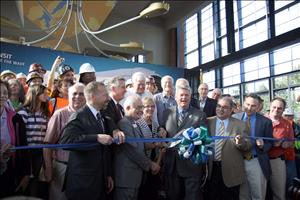On July 18, 2009, Seattle's light-rail era begins as Sound Transit's Link light-rail trains carry their first passengers between downtown Seattle and Tukwila in south King County. The event, anticipated for decades, is celebrated with a ribbon-cutting ceremony at Sound Transit's Mount Baker Station in the Rainier Valley neighborhood, presided over by Seattle mayor and Sound Transit board chair Greg Nickels (b. 1955). One passenger on the first day tells reporters, "It's about time. ... It makes Seattle feel like a real city" ("Seattle Hops on Board"). About 45,000 people ride the light-rail trains on the first day. The 14-mile line is known as the Central Link and it runs between Tukwila and downtown Seattle's Westlake Center Station. Within six months the Central Link line will be extended south another 1.7 miles to Sea-Tac Airport. This is the first stretch of what is planned to be a much more extensive light-rail system. Voters will eventually approve plans to extend the light-rail system to a total 116 miles in King, Pierce, and Snohomish counties, scheduled for completion in 2041.
Dark Days
Seattle ripped out its original rail-transit system -- its streetcars -- in 1941. In ensuing decades, voters were given several chances were to build a new rapid-transit rail system, notably in the Forward Thrust votes of 1968 and 1970, and in a 1995 Central Puget Sound Regional Transit Authority (RTA) vote. Voters rejected all three proposals.
Finally, in 1996, voters in King, Pierce, and Snohomish counties approved the $3.9 billion Sound Move measure, which called for the creation of a 22-mile light-rail system from Seattle-Tacoma International Airport to the University of Washington. The Central Puget Sound Regional Transit Authority rebranded itself as Sound Transit and went to work designing and building the light-rail system, which was given the name Link. (In addition to the UW-to-Sea-Tac line, the approved measure also included a separate Tacoma Link light-rail line running 1.6 miles from the Tacoma Dome to downtown Tacoma; that line opened in 2003.)
However, in late 2000 and early 2001, Sound Transit entered an era that came to be known by many involved as the "Dark Days." The agency admitted it had underestimated the cost of Link by $1.1 billion and no longer had the money to build the entire 22-mile line. The Sound Transit board immediately pushed the projected date for completing Link back from 2006 to 2009. This financial debacle also threatened Link's federal grant, which was a major source of its funding.
"This Was Worth It"
Joni Earl (b. 1953), Sound Transit's new executive director, was eventually able to restore the agency's reputation and its federal funding. Since the agency did not have the money to build the full 22-mile Link line, she split it into two sections -- the North Link, between downtown Seattle and the University of Washington, and the Central Link, between the airport and downtown. Sound Transit had the money to build one stretch, but not both. The North Link route, involving a massive tunnel beneath Capitol Hill, located between downtown and the university, had been the main reason for the faulty cost projections. So Earl and the Sound Transit board chose to build the Central Link route first. This is the route that opened on July 18, 2009 -- three years behind the original, overly optimistic schedule for opening all 22 miles of the planned Link line.
For the previous two years, Seattle Mayor Greg Nickels, a guiding force behind Sound Transit since its inception, had spent many hours driving along the construction route on Martin Luther King Jr. Way through southeast Seattle, anxiously watching the progress. He admitted he was nervous even on the day before the opening. Then, during the ribbon-cutting ceremony at the Mount Baker Station, he was able to finally enjoy Sound Transit's achievement. In an interview nine years later, Nickels said that all of his anxiety vanished as he cut the ribbon and took his first ride. "It felt like 22 years of filth was washed away ... filth is the wrong word. But 22 years of political challenges and engineering challenges. It just felt like -- this was worth it" (Nickels interview). At the ceremony, he told the gathered crowd "Kids growing up today will never know a region without light rail" ("Seattle Hops on Board").
Embracing Light Rail
The trains on the two inaugural trips that morning -- one northbound and one southbound -- were filled largely by people who had received tickets through radio giveaways. Ensuing trains that day were free and open to the public but, because of the crowds, Sound Transit had to limit how many people could embark at each stop so there would be room for other passengers down the line. Musical acts entertained waiting passengers at the stations. By the end of the day, 45,000 people had ridden on Link, and even more rode the next day, a Sunday. Over those two days, 92,000 people made the trip.
At the time of the opening, Sound Transit projected that 15,900 passengers would ride on an average weekday, and predicted that the average would rise to 26,600 after the Sea-Tac Airport extension opened in December 2009. By October 2012, actual ridership was averaging about 27,000 each weekday. In 2016, when the long-awaited North Link extension to the University of Washington's Husky Stadium was finally opened, Link ridership skyrocketed to an average of around 67,800 per weekday. Seattle-area commuters had clearly embraced the new era of light rail.

